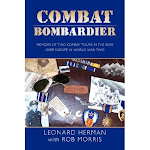

Crew No. 8 (Plane #40-2242, target Tokyo): 95th Bombardment Squadron, Capt. Edward J. York, pilot; Lt. Robert G. Emmens, copilot; Lt. Nolan A. Herndon, navigator/bombardier; SSgt. Theodore H. Laban, flight engineer; Sgt. David W. Pohl, gunner.
Richard Goldstein
October 15, 2007
NEW YORK - Nolan Herndon, a navigator-bombardier in the storied Doolittle raid over Japan in World War II who spent more than a year interned in the Soviet Union after his plane made an emergency landing in Russia, died yesterday in Columbia, S.C.
The cause was pneumonia, said his son Nolan Jr.
On April 18, 1942, a group of 16 Army Air Forces B-25 bombers, commanded by Lieutenant Colonel James H. Doolittle, took off from the carrier Hornet on a daylight bombing raid that carried the war to Japan for the first time.
The raid resulted in only light damage to military and industrial targets, but it buoyed morale on an American home front stunned by the Japanese attack on Pearl Harbor four months earlier, and Doolittle was awarded the Medal of Honor.
After completing their bombing runs, the planes were to land at airstrips in China that had not fallen to the Japanese. But they ran into a storm, forcing crash-landings and bailouts that killed three of the 80 crewmen. Eight others were captured by Japanese troops, with three of them later being executed and one who died of malnutrition while in captivity.

Mr. Herndon's plane, the eighth one off the Hornet, was the only bomber that never made it to China. It quickly ran low on fuel, evidently a result of carburetor adjustments during flight preparations in California. The plane bombed a factory and strafed an airfield, and then the pilot, Captain Edward York, headed toward Russia's Pacific port of Vladivostok as his only alternative to landing in Japan.
The bomber touched down at a small airport near Vladivostok, the crew hoping that it would receive gasoline and continue on to China. But the Soviet Union was not fighting Japan. As a neutral nation in the war between the United States and the Japanese, it interned the five crewmen.
While detained in European Russia, the crew members braved temperatures plunging to 50 degrees below zero, and they subsisted on cabbage, black bread, and tea.
"I can't blame the Russian people," Mr. Herndon told The State newspaper of Columbia, S.C., in 2002. "They were starving, too."
The airmen wrote a letter to Stalin, asking for their release, and while the note did not win their freedom, it did reach high-level Soviet authorities, who transferred them to a warm-weather area, a town about 15 miles north of the border with Iran, where they were assigned to work in a factory repairing trainer planes.
On May 26, 1943, the five airmen made their escape, paying a smuggler $250 to take them by truck to Iran. They found a British Consulate just across the border.
Mr. Herndon, a native of Greenville, Texas, raised cattle and ran a wholesale grocery business in South Carolina after the war.
In an interview with The State, in 2001, Mr. Herndon theorized that Captain York and his copilot, Lieutenant Robert Emmens, had received secret orders to fly to Vladivostok to test the willingness of Stalin's government to cooperate in the war against Japan. But Mr. Herndon had no direct evidence, and there has been no corroboration of his suspicions.
In addition to his son Nolan Jr., of West Columbia, S.C., Mr. Herndon leaves his wife, Julia; his son James, of Pawleys Island, S.C.; five grandchildren; and five great-grandchildren.

The crews of 11 bombers bailed out over China
One crew make a wheels-up crash landing in a rice paddy
Three bombers ditched in the waters off the China coast
One bomber landed in the Soviet Union where it was confiscated
Of the 80 men who flew with Lieutenant Colonel Doolittle:
3 were killed exiting their aircraft on the night of the raid8 were captured by the Japanese
3 POWs were executed by their captors on October 15, 19421 POW died of malnutrition and mistreatment while confined4 POWs were repatriated at the end of WWII after 40 months of captivity
Following the mission most of the raiders went on to fly other combat missions. Before the war ended:
10 raiders were killed in action in Europe, North Africa, and Indo-China 4 were shot down and interred as German prisoners of war
As of October 14, 2007 only twelve of the raiders are still living. They are:
William Bower
Thomas Griffin
David Jones
Charles Ozuk
Richard Cole
Robert Hite
Frank Kappeler
Edward Saylor
Jacob DeShazer
Edwin Horton
James Macia
David Thatcher
Source of Obituary: Boston Globe
Nolan Herndon, bomber in WWII Doolittle raid on Japan
Richard Goldstein
October 15, 2007
NEW YORK - Nolan Herndon, a navigator-bombardier in the storied Doolittle raid over Japan in World War II who spent more than a year interned in the Soviet Union after his plane made an emergency landing in Russia, died yesterday in Columbia, S.C.
Mr. Herndon, who lived in Edgefield, S.C., was 88.
The cause was pneumonia, said his son Nolan Jr.
On April 18, 1942, a group of 16 Army Air Forces B-25 bombers, commanded by Lieutenant Colonel James H. Doolittle, took off from the carrier Hornet on a daylight bombing raid that carried the war to Japan for the first time.
The raid resulted in only light damage to military and industrial targets, but it buoyed morale on an American home front stunned by the Japanese attack on Pearl Harbor four months earlier, and Doolittle was awarded the Medal of Honor.
After completing their bombing runs, the planes were to land at airstrips in China that had not fallen to the Japanese. But they ran into a storm, forcing crash-landings and bailouts that killed three of the 80 crewmen. Eight others were captured by Japanese troops, with three of them later being executed and one who died of malnutrition while in captivity.

Mr. Herndon's plane, the eighth one off the Hornet, was the only bomber that never made it to China. It quickly ran low on fuel, evidently a result of carburetor adjustments during flight preparations in California. The plane bombed a factory and strafed an airfield, and then the pilot, Captain Edward York, headed toward Russia's Pacific port of Vladivostok as his only alternative to landing in Japan.
The bomber touched down at a small airport near Vladivostok, the crew hoping that it would receive gasoline and continue on to China. But the Soviet Union was not fighting Japan. As a neutral nation in the war between the United States and the Japanese, it interned the five crewmen.
While detained in European Russia, the crew members braved temperatures plunging to 50 degrees below zero, and they subsisted on cabbage, black bread, and tea.
"I can't blame the Russian people," Mr. Herndon told The State newspaper of Columbia, S.C., in 2002. "They were starving, too."
The airmen wrote a letter to Stalin, asking for their release, and while the note did not win their freedom, it did reach high-level Soviet authorities, who transferred them to a warm-weather area, a town about 15 miles north of the border with Iran, where they were assigned to work in a factory repairing trainer planes.
On May 26, 1943, the five airmen made their escape, paying a smuggler $250 to take them by truck to Iran. They found a British Consulate just across the border.
Mr. Herndon, a native of Greenville, Texas, raised cattle and ran a wholesale grocery business in South Carolina after the war.
In an interview with The State, in 2001, Mr. Herndon theorized that Captain York and his copilot, Lieutenant Robert Emmens, had received secret orders to fly to Vladivostok to test the willingness of Stalin's government to cooperate in the war against Japan. But Mr. Herndon had no direct evidence, and there has been no corroboration of his suspicions.
In addition to his son Nolan Jr., of West Columbia, S.C., Mr. Herndon leaves his wife, Julia; his son James, of Pawleys Island, S.C.; five grandchildren; and five great-grandchildren.

History of the Doolittle Raid
Eighty men in five-man crews piloted the 16 B-25 bombers that bombed Japan on April 18, 1942. None of the bombers was shot down but all sixteen were lost:
The crews of 11 bombers bailed out over China
One crew make a wheels-up crash landing in a rice paddy
Three bombers ditched in the waters off the China coast
One bomber landed in the Soviet Union where it was confiscated
Of the 80 men who flew with Lieutenant Colonel Doolittle:
3 were killed exiting their aircraft on the night of the raid8 were captured by the Japanese
3 POWs were executed by their captors on October 15, 19421 POW died of malnutrition and mistreatment while confined4 POWs were repatriated at the end of WWII after 40 months of captivity
Following the mission most of the raiders went on to fly other combat missions. Before the war ended:
10 raiders were killed in action in Europe, North Africa, and Indo-China 4 were shot down and interred as German prisoners of war
As of October 14, 2007 only twelve of the raiders are still living. They are:
William Bower
Thomas Griffin
David Jones
Charles Ozuk
Richard Cole
Robert Hite
Frank Kappeler
Edward Saylor
Jacob DeShazer
Edwin Horton
James Macia
David Thatcher







No comments:
Post a Comment